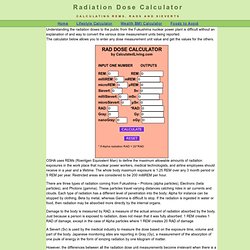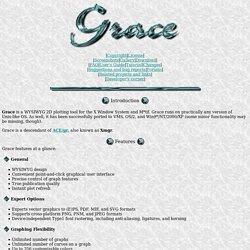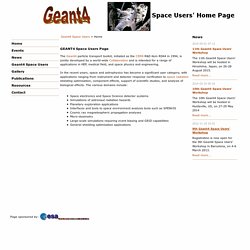

Radiation Dose Calculator. Understanding the radiation doses to the public from the Fukushima nuclear power plant is difficult without an explanation of and way to convert the various dose measurement units being reported.

The calculator below allows you to enter any dose measurement unit value and get the values for the others. OSHA uses REMs (Roentgen Equivalent Man) to define the maximum allowable amounts of radiation exposures in the work place that nuclear power workers, medical technologists, and airline employees should receive in a year and a lifetime. The whole body maximum exposure is 1.25 REM over any 3 month period or 5 REM per year. Restricted areas are considered to be 200 milliREM per hour. There are three types of radiation coming from Fukushima – Protons (alpha particles), Electrons (beta particles), and Photons (gamma). Damage to the body is measured by RAD, a measure of the actual amount of radiation absorbed by the body.
Email us at calculatedliving@gmail.com with any questions or comments. OpenScientist. 2.8. How to Set Up an Interactive Session. The code for the user examples in Geant4 is placed in the subdirectory examples of the main Geant4 source package.

This directory is installed to the share/Geant4-X.Y.Z/examples (where X.Y.Z is the Geant4 version number) subdirectory under the installation prefix. In the following sections, a quick overview will be given on how to build a concrete example, "ExampleB1", which is part of the Geant4 distribution, using CMake and the older, and now deprecated, Geant4Make system. 2.8.1. Using CMake to build Applications: Geant4Config.cmake Geant4 installs a file named Geant4Config.cmake located in: +- CMAKE_INSTALL_PREFIX +- lib/ +- Geant4-10.2.0/ +- Geant4Config.cmake which is designed for use with the CMake scripting language find_package command. We'll use Basic Example B1, which you may find in the Geant4 source directory under examples/basic/B1, to demonstrate the use of CMake to build a Geant4 application. 2.8.1.1. Our first step is to create a build directory in which build the example. Analysis.pdf. Vortrag_day5.pdf.
Gnuplot homepage. Demo scripts for gnuplot version 4.6. TEC-EES - NOAA Daily Plots. SLAC National Accelerator Laboratory. Grace Home. Grace is a WYSIWYG 2D plotting tool for the X Window System and M*tif.

Grace runs on practically any version of Unix-like OS. As well, it has been successfully ported to VMS, OS/2, and Win9*/NT/2000/XP (some minor functionality may be missing, though). Grace is a descendant of ACE/gr, also known as Xmgr. Grace features at a glance: Please refer to the Grace User's Guide for more detailed description. The FTP home of Grace is and it is daily mirrored at If you found a bug in Grace or wish to suggest some improvements, please do it on-line. Welcome to the CRÈME site — CREME-MC site. Geant4 Space Users - Welcome to the GEANT4 Space Users page. The Geant4 particle transport toolkit, initiated as the CERN R&D item RD44 in 1994, is jointly developed by a world-wide Collaboration and is intended for a range of applications in HEP, medical field, and space physics and engineering.

In the recent years, space and astrophysics has become a significant user category, with applications ranging from instrument and detector response verification to space radiation shielding optimisation, component effects, support of scientific studies, and analysis of biological effects. The various domains include: Space electronics and Space Science detector systems Simulations of astronaut radiation hazards Planetary exploration applications Interfaces and tools to space environment analysis tools such as SPENVIS Cosmic ray magnetospheric propagation analyses Micro-dosimetry Large-scale simulations requiring event biasing and GRID capabilities General shielding optimisation applications.